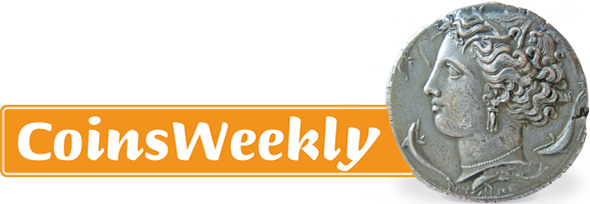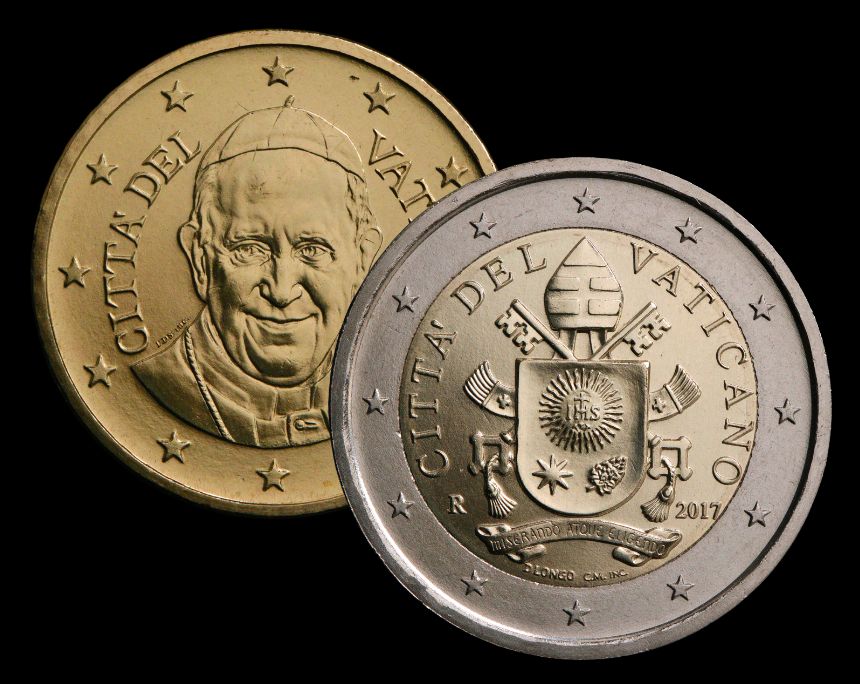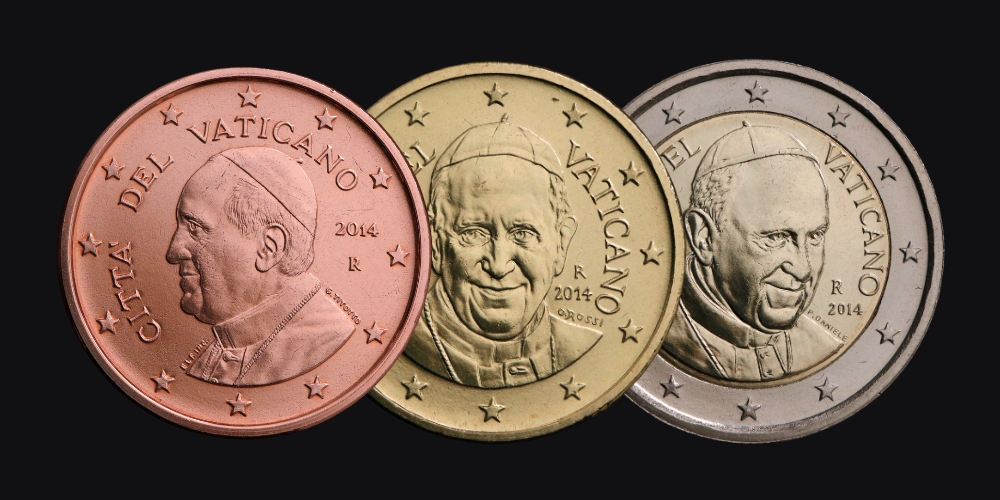Questions and Answers for Coin Collectors Regarding the Death of Pope Francis
By Sebastian Wieschowski
The death of Pope Francis on Easter Monday has stirred emotions among coin collectors around the world. We have compiled the most important questions relating to the euro coins of the tiny state.
Content
What happens to Vatican euro coins after the death of Pope Francis?
Following the Pope’s death, the Vatican enters the phase of Sede Vacante – Italian: Sede Vacante, or in German: “the vacant seat.” During this transitional period, the College of Cardinals temporarily assumes the administrative responsibilities of the Holy See. Pope Francis is scheduled to be buried on Saturday. According to the apostolic constitution Universi Dominici Gregis by Pope John Paul II, the conclave to elect a new pope may begin no sooner than 15 days after the pope’s death and no later than 20 days afterwards – the reason for this timeframe is to allow all cardinals from around the world sufficient time to travel to Rome.
Meanwhile, preparations are also being made for a numismatic commemoration of the Sede Vacante. In the past, the Vatican has commemorated this period in various ways – in 2005, following the death of Pope John Paul II, with a complete set of coins from 1 cent to 2 euro in a special edition, and in 2013 with a 2-euro commemorative coin.
Will there be a Sede Vacante commemorative coin in 2025?
That remains unclear – the Vatican’s official coin distribution office for collectors has been undergoing a phase of reorganisation for several months. It is therefore still uncertain whether a 2-euro commemorative coin will actually be issued in 2025 – collectors are still waiting for the second 2-euro commemorative coin from the 2024 series. Legally, however, the situation is clear: EU Regulation 651/2012, Article 4, Paragraph 2, allows the Vatican to issue a third 2-euro commemorative coin in a year – “if the position of the Head of State is temporarily unoccupied or provisionally filled.”
Why is a Sede Vacante circulation coin set unlikely?
According to EU Regulation 729/2014, Article 7, Paragraph 2, the national sides of circulation coins may be changed when the Head of State changes. However, a temporary resignation or vacancy does not justify the right to a redesign:
“(2) Without prejudice to paragraph 1, changes to the designs used for the national sides of regular coins may be made when the Head of State depicted or referred to on the coin is replaced. However, if the position of the Head of State is only temporarily unoccupied or provisionally filled, this does not justify an additional right to make such changes.”
Even though the Vatican is not explicitly mentioned here, the regulation is clearly directed at Rome.
What might a Sede Vacante coin look like?
Future Sede Vacante commemorative coins from the Vatican – which could be issued in 2025 to mark the death of Pope Francis – will likely once again feature the coat of arms of the Apostolic Chamber, as was the case in 2005 and 2013. The coat of arms traditionally consists of three main elements: two crossed keys (symbolising the succession of Peter), an “ombrellino” (a papal umbrella used only during a Sede Vacante), and the personal escutcheon of the acting Camerlengo (Cardinal Chamberlain), often accompanied by initials or heraldic symbols.
The Camerlengo of the Holy Roman Church (Cardinal Chamberlain) is responsible for managing the Vatican’s temporal goods during the Sede Vacante. He heads the Apostolic Chamber and organises preparations for the conclave in cooperation with the College of Cardinals. The Camerlengo officially confirms the Pope’s death, seals his apartments, and assumes interim administrative duties – but not the spiritual or doctrinal authority of the Pope. Currently, Cardinal Kevin Joseph Farrell holds the position of Camerlengo. He was appointed to this office by Pope Francis in 2019.
Why is the Vatican allowed to mint euro coins at all?
The euro has been the official currency of Vatican City since 1 January 2002. Although the Vatican is not an EU member, it concluded a monetary agreement with the European Community (represented by Italy) on 29 December 2000. This agreement allows the Vatican to issue its own euro coins within a limited scope. Initially, the annual minting limit was set at €670,000. From 1 January 2004, the limit was raised to €1 million. In addition, the Vatican was permitted to mint up to another €300,000 worth of coins in special years – such as a Sede Vacante, a Holy Year, or the beginning of a council. This also applied to exceptional events such as a pope’s death (2005) or resignation (2013).
At the end of 2009, the monetary agreement was updated once again: since 2010, the annual coin quota has been calculated based on a fixed amount (in 2010: €2.3 million) plus a variable portion depending on the Vatican’s population. In return, the Vatican agreed to put at least 51% of the coins into circulation at face value – previously, nearly all coins had been sold to collectors at inflated prices. In fact, the Vatican began issuing, for example, 50-cent coins as change within its territory starting in 2010 (2 million 50-cent pieces were minted that year). Nevertheless, Vatican euro coins remain by far the rarest in the eurozone. Due to the small mintages, they rarely enter regular circulation; virtually all examples are secured by collectors.
How did the euro introduction unfold in the Vatican?
With the euro’s introduction in 2002, the Vatican issued its first euro circulation coins – exclusively as official coin sets for collectors. The first set was released in 2002, comprising all eight denominations from 1 cent to 2 euro, bearing the portrait of Pope John Paul II (issued in Brilliant Uncirculated and Proof quality). The mintage was limited to around 65,000 BU sets and 9,000 Proof sets. Additionally, the Vatican provided its citizens and employees with a euro starter kit containing coins worth €3.88. This starter kit, released on 1 March 2002, was reportedly limited to about 2,000 pieces and later fetched substantial prices among collectors (over €600 for an unopened kit). The Vatican thus launched with extremely limited coin distribution – resulting in the first Vatican euro coins quickly selling out and fetching four-figure sums on the secondary market (in 2002, a Proof set reached over €2,000 at its peak). The Vatican’s issuing office, Ufficio Filatelico e Numismatico (UFN), initially prioritised subscribers; long waiting lists and a thriving grey market characterised the early days.
What did the coins under John Paul II (2002–2005) look like?
The first coin series (2002–2005) depicted the profile of His Holiness Pope John Paul II facing left, encircled by the country’s name “CITTÀ DEL VATICANO” and the twelve EU stars. This design appeared on all eight denominations (1 cent to 2 euro). The series was created by Italian medallist Guido Veroi, whose initials “GV” can be found on the coins. The edge inscription of the 2-euro coin, as is customary for the Vatican, reads “2✠ ✠ 2✠ ✠ 2✠ ✠ 2✠ ✠ 2✠ ✠” (a sequence of “2✠”). Each year saw the release of a new coin set with the same motif. In 2004, mintages were slightly increased (to 85,000 BU sets) in line with the raised minting limit. All coins bear the “R” mintmark for Rome and the respective year. Interestingly, the Pope’s name was not inscribed on the coins – his likeness alone sufficed for identification. This first series remained in use until Pope John Paul II’s death in April 2005. Coins dated 2005 with his portrait were still minted (85,000 sets), released shortly before or after his passing.
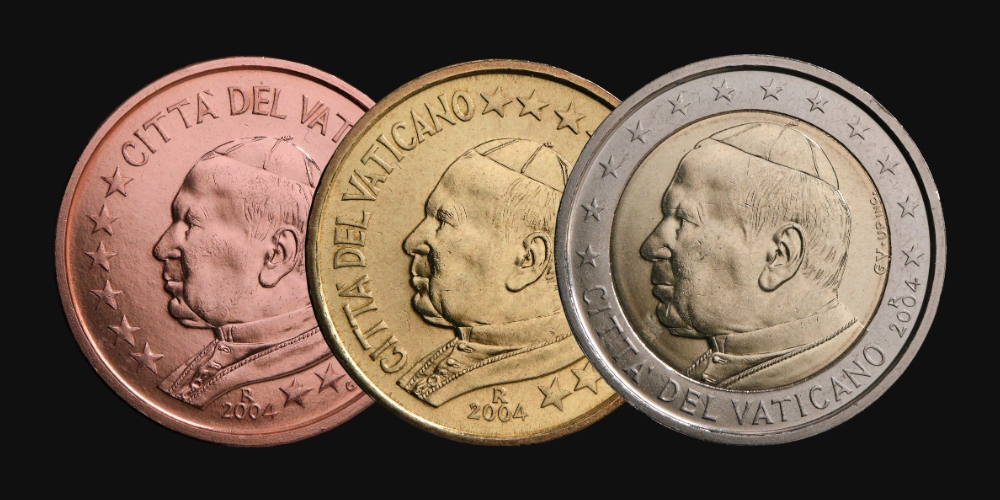
The Vatican’s first circulation coin series featuring the image of Pope John Paul II became a coveted item among collectors at the launch of the euro. Photo: Wieschowski
How was the first Sede Vacante of the euro era commemorated in 2005?
After the death of John Paul II, a Sede Vacante (sede vacante = “empty seat of Peter”) began, lasting until the election of his successor. In this papal interregnum, the right to issue coins traditionally passes to the Camerlengo. The Vatican used this opportunity in 2005 to issue a unique Sede Vacante coin set. This second series (2005) features, instead of a papal portrait, the coat of arms of the acting Camerlengo (Cardinal Eduardo Martínez Somalo) beneath the insignia of the Apostolic Chamber – two crossed keys with the traditional ombrellino (ceremonial umbrella). The inscription “SEDE VACANTE MMV” also appears on the coins. The series was designed by Daniela Longo, whose initials “DL” appear on the coins. The 2005 Sede Vacante coins were issued in limited quantities and are highly sought after numismatically, as they uniquely mark the transition between two pontificates. In fact, the 2005 coin set remains an exception – more recent EU regulations prohibit a dedicated circulation series for a Sede Vacante.
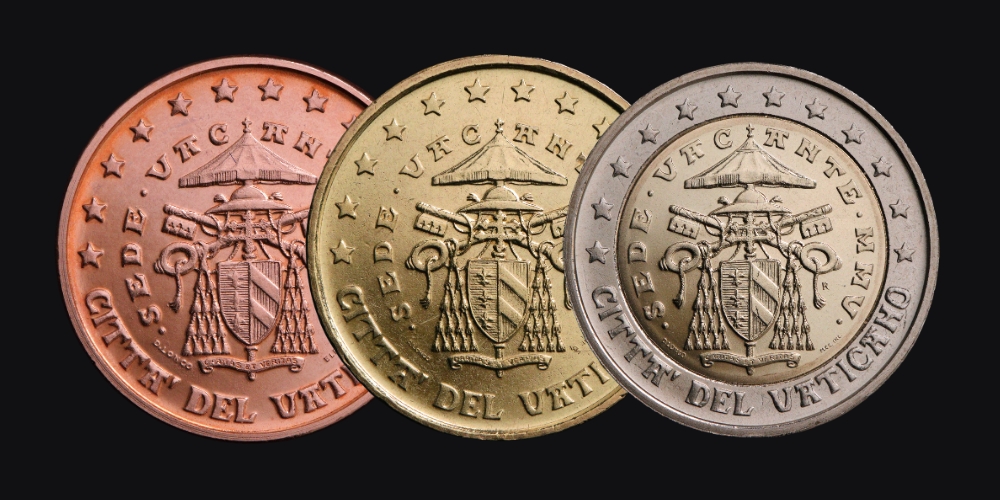
Numismatic curiosity: In 2005, the Vatican issued two coin sets – one with Pope John Paul II and one for the Sede Vacante. Photo: Wieschowski
How was Benedict XVI commemorated on euro coins between 2006 and 2013?
Following the election of Pope Benedict XVI, the third coin series (2006–2013) was launched in April 2006. All denominations now featured the portrait of Benedict XVI (three-quarter profile), surrounded by “CITTÀ DEL VATICANO” and the twelve stars. Again, the design remained consistent throughout his pontificate. Daniela Longo was once more responsible for the design. The first sets with Benedict’s image were released in 2006, and official coin sets were issued annually (typically ~85,000 BU, ~12,000–15,000 Proof). During this pontificate, the Vatican also began regularly issuing 2-euro commemorative coins. In 2013, a turning point came: Pope Benedict XVI unexpectedly resigned on 28 February 2013. For the first time, a Sede Vacante occurred not due to death, but due to resignation.
The 2013 Sede Vacante coin mirrored the design of 2005, displaying the coat of arms of the Camerlengo and the crossed keys beneath the ombrellino, framed by “CITTÀ DEL VATICANO – SEDE VACANTE MMXIII.” It was minted in 125,000 copies and was quickly snapped up by collectors.
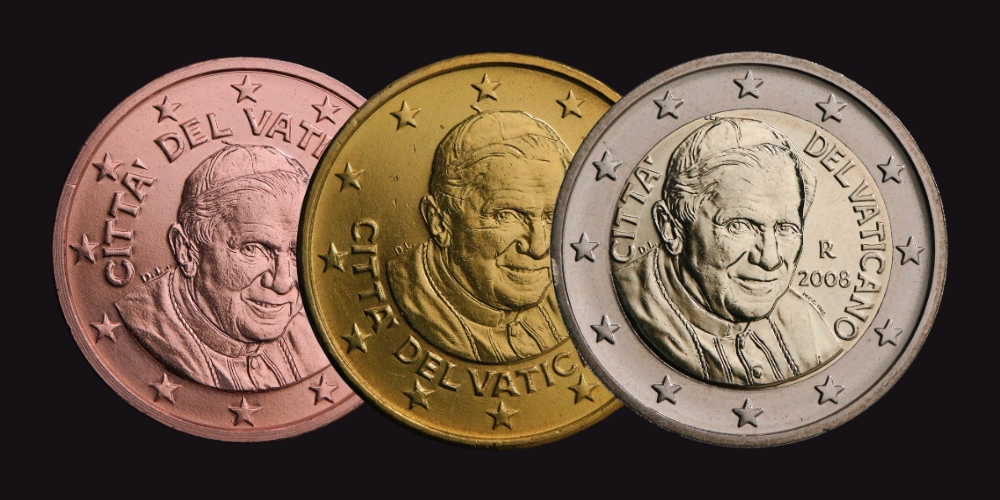
A German on euro coins: Pope Benedict continued his predecessor’s tradition and commissioned only one coin portrait for all denominations. Photo: Wieschowski
How did the numismatic era of Pope Francis begin in 2014?
Following the election of Pope Francis in March 2013, a new coin series was launched in 2014. The fourth series (2014–2016) once again featured the image of the pope, but with a distinctive feature: three different papal portraits were used, depending on the denomination. The smaller cent coins showed Francis in left profile, the 10 to 50 cent coins used a frontal portrait, and the 1 and 2 euro coins showed him in right profile. This design diversity made the Francis coins particularly striking. Three artists from the Italian Mint were responsible: Gabriella Titotto (1, 2, 5 cent), Orietta Rossi (10, 20, 50 cent), and Patrizio Daniele (1 euro and 2 euro). As usual, the inscriptions “CITTÀ DEL VATICANO” and twelve stars surrounded the images. The first Francis coin sets were issued in March 2014.
Why were Vatican euro coins redesigned during Pope Francis’s term?
However, a significant change came in 2017: Pope Francis requested that his portrait no longer appear on circulation coins. As a result, the fifth series (since 2017) was introduced on 1 March 2017, featuring his papal coat of arms instead of his likeness. Francis justified this move by citing his modest view of the papacy – he did not wish to be “venerated” in everyday financial transactions. Since then, each coin has displayed the papal coat of arms as a symbol of the Head of State, designed by artist Daniela Longo. This decision makes the Vatican the only euro-issuing state that refrains from depicting its head of state on circulating coins. All previously issued series (1–5) remain legal tender throughout the eurozone.
The redesign of Vatican euro coins at the request of Pope Francis – removing his own portrait in favour of his coat of arms – was technically not covered by EU regulations. Such changes are normally only permitted every 15 years, as stated in Article 7, Paragraph 1 of EU Regulation 729/2014.
How should the Vatican’s coin issuance policy be viewed?
The Vatican’s coin issuance strategy serves both to underline its sovereignty as a microstate and to generate significant revenue. Due to limited minting quotas and high demand, Vatican euro coins fetch considerable collector premiums. The very first coin sets from 2002 were already traded well above face value. This meant the coins were rarely used in actual circulation and instead ended up almost exclusively in private collections.
The EU criticised this practice and revised the agreements in 2010 to encourage more coins to enter circulation. Since then, as mentioned, 51% of the coins must be issued at face value – a target the Vatican meets primarily by minting large quantities of specific denominations (e.g. 50-cent pieces) and using them as change in Vatican retail outlets. Tourists therefore have a small chance of finding Vatican coins in their wallets – something previously almost impossible. Even so, Vatican euros remain rare: with the smallest mintages of all euro coins, they are symbolic of numismatic treasures within the euro area.
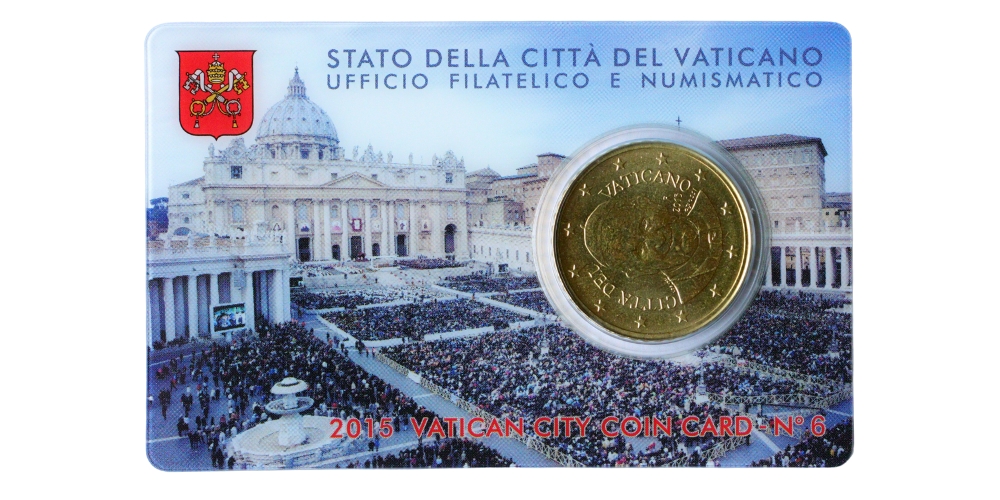
Coincards offered an affordable way to obtain a Vatican euro coin featuring Pope Francis. Photo: Wieschowski
What are Vatican Coincards all about?
As early as 2010, the Vatican began issuing Coincards as numismatic souvenirs. The first Coincard featured a night view of St. Peter’s Basilica and included a 50-cent coin bearing the portrait of Pope Benedict, encased in a hard plastic card. The mintage was 120,000 units. From 2011 onwards, thematically matched postage stamps were also integrated into individual Coincards. The number of Coincards was steadily expanded over the following years – from 2 pieces in 2011 and 2012, to 3 in 2013, then 5 from 2015 onwards, and since 2023, even 6 Coincards per year are produced. Since 2022, in addition to 50-cent coins, 1-euro coins from the Vatican have also been included in Coincards. By 2023, a total of 63 official Vatican Coincards had been released.

Even after the Vatican coins no longer featured the likeness of Francis, the Pope continued to be depicted on the Vatican’s Coincards. Photo: Wieschowski
How has the mintage of Vatican euro coins developed?
To this day, the Vatican remains popular among euro collectors, but mintage figures have been steadily declining for years. While 65,000 coin sets were issued in 2002 and 85,000 sets in 2004, and even 94,000 pieces in both 2010 and 2011, numbers have fallen sharply since 2015. In 2020, only 37,000 coin sets in Brilliant Uncirculated quality were issued, and in 2024 only 25,000 sets were produced. A similar trend is seen with the 2-euro coins: in 2016, for the first time, fewer than 100,000 pieces were minted, and the figure now stands at around 70,000 per 2-euro commemorative coin. Interest in Vatican euro coins is thus decreasing – and so are market prices: coin sets can now be obtained for as little as €40 and 2-euro commemoratives from €25.






